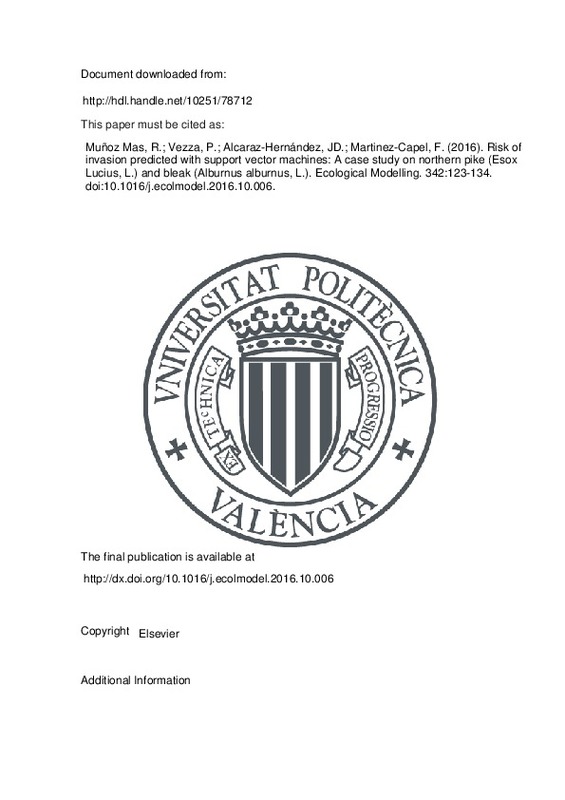JavaScript is disabled for your browser. Some features of this site may not work without it.
Buscar en RiuNet
Listar
Mi cuenta
Estadísticas
Ayuda RiuNet
Admin. UPV
Risk of invasion predicted with support vector machines: A case study on northern pike (Esox Lucius, L.) and bleak (Alburnus alburnus, L.)
Mostrar el registro sencillo del ítem
Ficheros en el ítem
| dc.contributor.author | Muñoz Mas, Rafael
|
es_ES |
| dc.contributor.author | Vezza, Paolo
|
es_ES |
| dc.contributor.author | Alcaraz-Hernández, Juan Diego
|
es_ES |
| dc.contributor.author | Martinez-Capel, Francisco
|
es_ES |
| dc.date.accessioned | 2017-03-13T15:26:46Z | |
| dc.date.available | 2017-03-13T15:26:46Z | |
| dc.date.issued | 2016-12-24 | |
| dc.identifier.issn | 0304-3800 | |
| dc.identifier.uri | http://hdl.handle.net/10251/78712 | |
| dc.description.abstract | The impacts of invasive species are recognised as a major threat to global freshwater biodiversity. The risk of invasion (probability of presence) of two avowed invasive species, the northern pike (Esox Lucius, L.) and bleak (Alburnus alburnus, L.), was evaluated in the upper part of the Cabriel River (eastern Iberian Peninsula). Habitat suitability models for these invasive species were developed with Support Vector Machines (SVMs), which were trained with data collected downstream the Contreras dam (the last barrier impeding the invasion of the upper river segment). Although SVMs gained visibility in habitat suitability modelling, they cannot be considered widespread in ecology. Thus, with this technique, there is certain controversy about the necessity of performing variable selection procedures. In this study, the parameters tuning and the variable selection for the SVMs was simultaneously performed with a genetic algorithm and, contradicting previous studies in freshwater ecology, the variable selection proved necessary to achieve almost perfect accuracy. Further, the development of partial dependence plots allowed unveiling the relationship between the selected input variables and the probability of presence. Results revealed the preference of northern pike for large and wide mesohabitats with vegetated shores and abundant prey whereas bleak preferred deep and slightly fast flow mesohabitats with fine substrate. Both species proved able to colonize the upper part of the Cabriel River but the habitat suitability for bleak indicated a slightly higher risk of invasion. Altogether may threaten the endemic species that actually inhabit that stretch, especially the Jucar nase (Parachondrostoma arrigonis; Steindachner), which is one of the most critically endangered Iberian freshwater fish species. (C) 2016 Elsevier B.V. All rights reserved. | es_ES |
| dc.description.sponsorship | The study has been partially funded by the IMPADAPT project (CGL2013-48424-C2-1-R) with Spanish MINECO (Ministerio de Economia y Competitividad) and by the Confederacion Hidrografica del Jucar (Spanish Ministry of Agriculture, Food and Environment). We also want to thank all the colleagues who worked in the field data collection, especially Rui M. S. Costa and Aina Hernandez. Finally, we are especially grateful to Esther Lopez Fernandez who kindly and selflessly posed for the graphical abstract. | en_EN |
| dc.language | Inglés | es_ES |
| dc.publisher | Elsevier | es_ES |
| dc.relation.ispartof | Ecological Modelling | es_ES |
| dc.rights | Reserva de todos los derechos | es_ES |
| dc.subject | Genetic algorithm | es_ES |
| dc.subject | Habitat suitability model | es_ES |
| dc.subject | Iberian Peninsula | es_ES |
| dc.subject | Mediterranean river | es_ES |
| dc.subject | Mesohabitat scale | es_ES |
| dc.subject | Variable selection | es_ES |
| dc.subject.classification | TECNOLOGIA DEL MEDIO AMBIENTE | es_ES |
| dc.title | Risk of invasion predicted with support vector machines: A case study on northern pike (Esox Lucius, L.) and bleak (Alburnus alburnus, L.) | es_ES |
| dc.type | Artículo | es_ES |
| dc.identifier.doi | 10.1016/j.ecolmodel.2016.10.006 | |
| dc.relation.projectID | info:eu-repo/grantAgreement/MINECO//CGL2013-48424-C2-1-R/ES/ADAPTACION AL CAMBIO GLOBAL EN SISTEMAS DE RECURSOS HIDRICOS/ | es_ES |
| dc.rights.accessRights | Abierto | es_ES |
| dc.contributor.affiliation | Universitat Politècnica de València. Instituto de Investigación para la Gestión Integral de Zonas Costeras - Institut d'Investigació per a la Gestió Integral de Zones Costaneres | es_ES |
| dc.contributor.affiliation | Universitat Politècnica de València. Departamento de Ingeniería Hidráulica y Medio Ambiente - Departament d'Enginyeria Hidràulica i Medi Ambient | es_ES |
| dc.contributor.affiliation | Universitat Politècnica de València. Escuela Politécnica Superior de Gandia - Escola Politècnica Superior de Gandia | es_ES |
| dc.description.bibliographicCitation | Muñoz Mas, R.; Vezza, P.; Alcaraz-Hernández, JD.; Martinez-Capel, F. (2016). Risk of invasion predicted with support vector machines: A case study on northern pike (Esox Lucius, L.) and bleak (Alburnus alburnus, L.). Ecological Modelling. 342:123-134. https://doi.org/10.1016/j.ecolmodel.2016.10.006 | es_ES |
| dc.description.accrualMethod | S | es_ES |
| dc.relation.publisherversion | http://dx.doi.org/10.1016/j.ecolmodel.2016.10.006 | es_ES |
| dc.description.upvformatpinicio | 123 | es_ES |
| dc.description.upvformatpfin | 134 | es_ES |
| dc.type.version | info:eu-repo/semantics/publishedVersion | es_ES |
| dc.description.volume | 342 | es_ES |
| dc.relation.senia | 321974 | es_ES |
| dc.contributor.funder | Ministerio de Economía y Competitividad | es_ES |
| dc.contributor.funder | Confederación Hidrográfica del Júcar | es_ES |







![[Cerrado]](/themes/UPV/images/candado.png)

